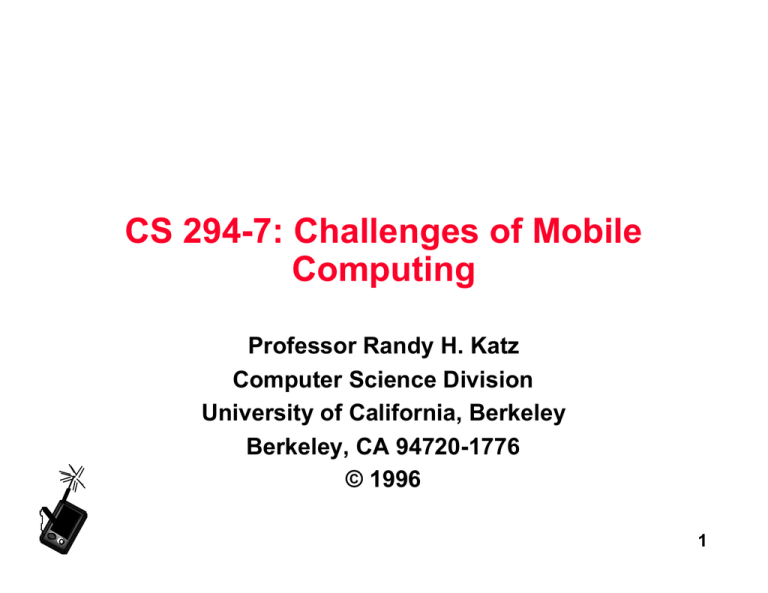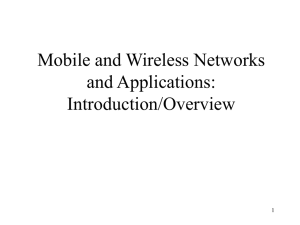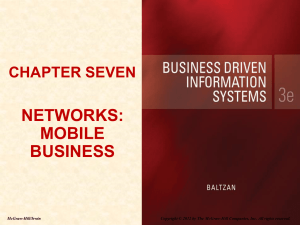CS 294-7: Challenges of Mobile Computing
advertisement

CS 294-7: Challenges of Mobile Computing Professor Randy H. Katz Computer Science Division University of California, Berkeley Berkeley, CA 94720-1776 © 1996 1 Natural Evolution of Computing More Flexible Resource Usage Mobile Computing LANs + WSs Networking Timesharing Batch Single User OS Freedom from Collocation 2 Research Issues in Mobile Computing • Wireless Communications – Quality of connectivity – Bandwidth limitations • Mobility – Location transparency – Location dependency • Portability – Power limitations – Display, processing, storage limitations 3 Classes of Mobile Devices • Display Only – InfoPad model: limited portable processing – Constrained to operation within prepared infrastructure, like a cordless phone – Advantages with respect to power consumption, upgrade path, lightweight, impact of lost/broken/stolen device • Laptop Computer – Thinkpad model: significant portable processing, operates independently of wireless infrastructure – Disadvantages: power consumption, expensive, significant loss exposure, typically greater than 5 pounds • Personal Digital Assistant – Somewhere between these extremes 4 Wireless Communications • Harsh communications environment: – Lower bandwidth/higher latency: good enough for videoconferencing? – Higher error rates – More frequent disconnection – Performance depends on density of nearby users but inherent scalability of cellular/frequency reuse architecture helps • Connection/Disconnection – Network failure is common – Autonomous operation is highly desirable » Caching is a good idea, e.g., web cache – Asynchronous/spool-oriented applications, like mail or printing » Trickle back data when bandwidth is available – Disconnected file systems: CODA (CMU), Ficus (UCLA) 5 Wireless Communications • Low Bandwidth – Orders of magnitude differences between wide-area, inbuilding wireless • Variable Bandwidth – Applications adaptation to changing quality of connectivity » High bandwidth, low latency: business as usual » High bandwidth, high latency: aggressive prefetching » Low bandwidth, high latency: asynchronous operation, use caches to hide latency, predict future references/trickle in, etc. etc. • Heterogeneous Networks – “Vertical Handoff” among colocated wireless networks 6 Heterogeneous “Wireless Overlay” Networks Regional-Area Remote Clinics Metropolitan-Area Emergency Dispatch Campus-Area Packet Relay Hospital Campus In-Building Hospital Operating Room Emergency Room 7 Wireless Communications Bandwidths and Latencies Type of Network Bandwidth In-Building >> 1 Mbps Latency Mobility < 10 ms Comm’l RF: 2 Mbps Research IR: 50 Mbps Campus-Area Packet Relay Network Wide-Area Regional-Area (LEO/DBS/VSAT) ≈ 64 Kbps ≈ 100 ms 19.2 Kbps > 100 ms 4.8 kbps–10+ Mbps > 100 ms (asymmetric) Typ Video Typ Audio Performance Performance Pedestrian 2-Way ’ractive Full Frame Rate (Comp) Pedestrian Med. Quality Slow Scan High Quality 16-bit Samples 22 Khz Rate Med. Quality Reduced Rate Vehicular Freeze Frame Asynchronous “Voice Mail” Vehicular Seconds/Frame Stationary Freeze Frame Asynchronous “Voice Mail” Contrast with 100 mbps Fast Ethernet or 155 mbps ATM Plus these bandwidths are SHARED among colocated users! Immediate future: 20 mbps wireless in-building (European HiperLAN) 64 kbps wide area (European GSM) InfoPad: 200 mbps CDMA radio/2 mbps per user 8 Wireless Communications • Security Concerns – Authentication is critical » Normal network point of attachment is a wall tap » Wireless access makes network attachment too easy – Exposure to over-the-air wiretapping » Any transmitter can also be a receiver! » Some wireless networks provide secure airlinks (e.g., CDPD) » Made more difficult by spread spectrum technologies 9 Mobility • Address Migration – Existing applications send packets to a fixed network address – Need to support dynamically changing “local” addresses as mobile device moves through network – Mobile IP specification: home environment tracks mobile device’s current location through registration procedure – Route optimization: exploit local caches of <global destination node addresses, current care-of address> – Location updates: » Forwarding » Hierarchical mobility agents – Other routing issues: e.g., multicast 10 Mobility: IP Routing Source Berkeley CS Internet Destination IPhome Sockets TCP/UDP IP Link Layer Physical Layer 11 Mobility: Mobile IP Correspondent Host Berkeley CS Home Agent Route Optimization Internet Home Network Sockets TCP/UDP Mobile IP Stanford CS Visited Network Foreign Agent Link Layer Physical Layer Mobile Host 12 Mobility • Location Dependent Services – Discovery: What services exist in my local environment? e.g., printers, file and compute services, special local applications, etc. – Follow me services: “Route calls to my current location,” “Migrate my workstation desktop to the nearest workstation screen” – Information services: » Broadcast/“push” information (e.g., “Flight 59 will depart from Gate 23”) » “Pull” information (e.g., “What gate will Flight 59 depart from?”) – Service migration: computations, caches, state, etc. follow mobile device as it moves through the network – Privacy: what applications can track user locations? 13 Portability • Low Power – Limited compute performance – Low quality displays • Loss of Data – Easily lost – Must be conceived as being “network-integrated” • Small User Interface – Limited real estate for keyboards – Icon intensive/handwriting/speech • Small Local Storage – Flash memory rather than disk drive 14 Portability Issues • It’s the power, stupid!! • Batteries – Weight, volume determine lifetime » 20 W-hrs per pound » 2 pounds, 10 hours = 2 W power consumption! – Power consumption: CV2ƒ » Reduce C by increased VLSI integration and MCM technology » Reduce V to lower operating voltages: 5 V to 3.3V to 2.5V and below » Reduce ƒ by reducing clock frequency, standby and suspend power modes » Intelligent operation: spin-down disk drives 15 Watt-hours per kg Battery Technology Lighter 200 150 100 Li Ion 50 NiCd NiMH 0 • Other Battery Types: – – – – Li Poly 0 50 100 150 200 250 300 Watt-hours per liter Smaller Lead Acid Nickel Zinc Rechargeable Alkaline-Manganese Zinc Air Dell Latitude Apple Powerbooks 16 Some PDA Product Parameters Mem Size 128 KBytes MHz Proc 20 Z-80 Batteries # Hrs Type 40 3 AAs Apple Newton Message Pad 640 KBytes 20 ARM 6-8 4 AAAs 0.9 240x336 11.2 Apple Newton 110 Pad 1 MByte 20 ARM 50 4 AAs 1.25 240x320 11.8 Casio Z-7000 1 MByte 7.4 8086 100 3 AAs 1.0 320x256 12.4 Sharp Expert Pad 640 KBytes 20 ARM 20 4 AAAs Armstad Pen Pad PDA 600 Display lbs. Pixels sq in 0.9 240x320 10.4 0.9 240x336 11.2 17 Some PDA Product Parameters Mem Size 1 MByte MHz Proc 8 8086 AT&T EO 440 Pers Comm 4-12 MBytes 20 Portable PC 4-16 MBytes 33+ Tandy Z-550 Zoomer Batteries # Hrs Type 100 3 AAs Hobbit 1-6 486 1-6 NiCd NiCd Display lbs. Pixels sq in 1.0 320x256 12.4 2.2 640x480 25.7 5-10 640x480 40 18 Typical Laptop Power Consumption Base System (2 MB, 25 MHz) Base System (2 MB, 10 MHz) Base System (2 MB, 5 MHz) Screen backlight Hard drive motor Math co-processor Floppy drive External keyboard LCD screen Hard drive active IC card slot Additional Mem (per MB) Parallel port Serial port 3.650 W 3.150 2.800 1.425 1.100 0.650 0.500 0.490 0.315 0.125 0.100 0.050 0.035 0.030 1.8 in PCMCIA hard drive Cell telephone (active) Cell telephone (inactive) Infrared network PCMCIA modem, 14.4 kbps PCMCIA modem, 9.6 kbps PCMCIA modem, 2.4 kbps GPS receiver 0.7-0.3 W 5.400 0.300 0.250 1.365 0.625 0.565 0.670 19 Laptop Power Consumption Compaq LTE 386/s20 10% 8% 5% 1% Display Edge Light CPU/Memory Hard Disk Floppy Disk Display Keyboard 31% 35% 20 InfoPad Power Consumption .075 W 3.0 W 1.25 W .175W Custom Chips (5V) µProc + PL Mono LCD Color LCD Pen Digitizer Up/Down Radios 2.1 W 2.4 W 21 Putting It All Together: Concepts in Mobile Computing • Identification – Subscriber mobility: 700 phone number – Terminal mobility: mobile phone # or IP address – Application mobility • Registration – Authentication: who are you? – Authorization: what can you do? – Allocation: how much will I give you? • Call/Connection Establishment – Mobile Routing: Mobile IP, Cellular System HLR/VLR – Resource Reservations: Reserve channels in advance – Location Update: forward vs. hierarchy 22 Putting it All Together: Concepts in Mobile Computing • Mobility – Handoff: when to do it, choice of network – Process Migration: application support infrastructure that follows the mobile • Privacy and Security – Authentication – Authorization – Encryption: over-the-air security 23




